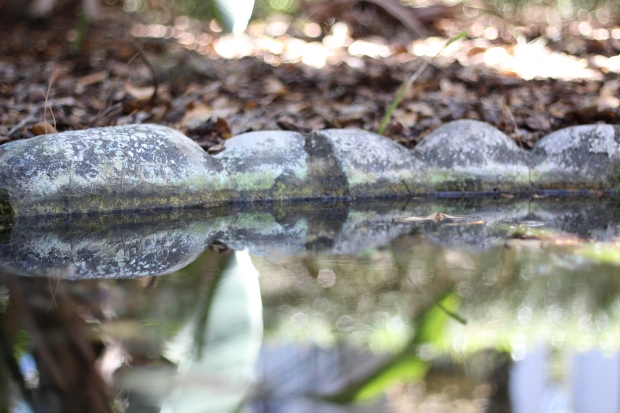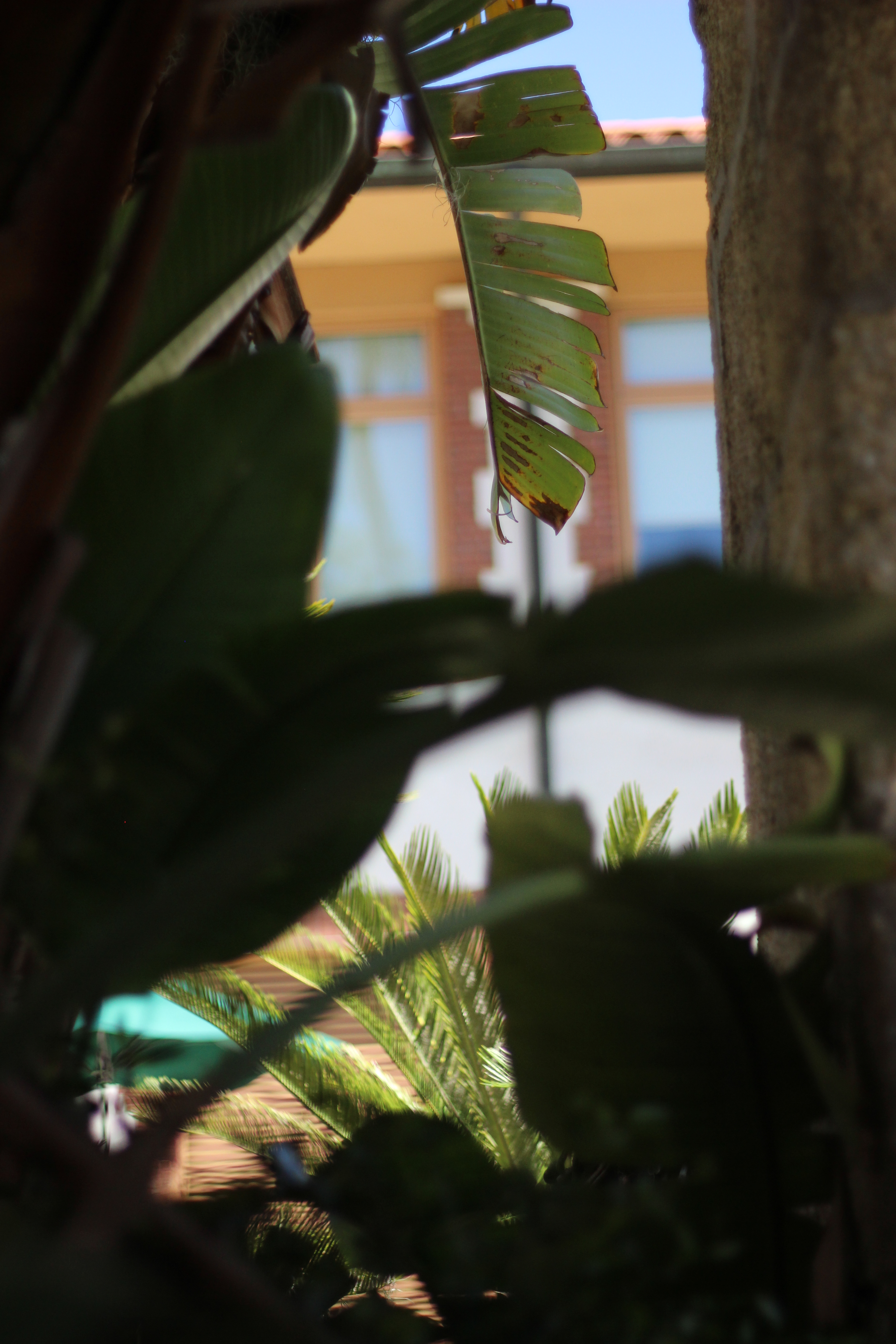I’m done with college! Well, sort of… I am done with my freshman year of college. It was a whirlwind of a year filled with new experiences, good and bad. However, I am not here to discuss my first year of college. I am here to discuss Markland Pond. (Don’t worry, it will make sense soon) My professors for Environmental English and Science asked me to write an ecological profile of a place, honing in on my inner Henry David Thoreau and E. O. Wilson. The place I chose to write my profile on was a little pond on campus; here is the final product:
Markland Pond isn’t exactly a pond. It is more like a small puddle of water with rocks around it, nestled underneath palms between Markland House and the Ringhaver Student Center and behind the Crisp Ellert Art Museum. I first stumbled upon this little pond last semester when my friends and I were exploring our new and exciting stomping grounds. We thought we made a grand discovery, and dubbed the pond “Shrek’s Swamp,” fully believing that this tiny body of water was part of the natural world that the school decided to preserve. When tasked with finding my “spot” for observation, I immediately wanted somewhere secluded and quiet, somewhere that no one would go and I could just sit and think. The pond was always in the back of my mind since finding it, but I never truly considered it until I was asked to find a place around town that intrigued me. Shrek’s Swamp, or rather Markland Pond as it’s more formally known, is extremely intriguing to a person like me, who values alone time and places that no one else knows about. I threw on some comfy clothes, grabbed a pen, paper, and beach towel, and made the quick walk across campus to observe what I thought was a natural beauty right across the street. I thought this little pond would be my golden ticket to solitude; however, I quickly realized that I was completely wrong, seeing as though the pond was quite the opposite of quiet. During all my visits to the pond, the area around the pond was buzzing with students and professors alike, all going about their busy, stressful days. Many of these busybodies did not even notice the tiny pond, let alone me sitting there observing them. Still, there were no tourists or screaming kids, so I was content.

Close Up of the Pond
Much to my dismay, Markland Pond wasn’t quite as grand during the daylight as it was on the night I discovered it. That is, until I sat down and observed it. My first observation of the pond was on April 5th, at exactly noon. Within the first five minutes of sitting there, a bird flew into a tree, a lizard scurried off in terror due to my presence, and I realized that the pond was man-made and quite possibly filled with sewage. Nevertheless, I persisted. I was determined to learn all I could about this little hidden treasure, so I began to write down everything I observed, thought, or found interesting. As I mentioned before, Markland Pond lies between Markland House and the Ringhaver Student Center, and adjacent to the Crisp Ellert Art Museum, all three highly trafficked buildings on campus. The actual pond is surrounded on three sides by different species of palm trees and small plants. On the fourth side is a large coquina wall, which does not seem to serve much purpose. The pond itself is situated in a small field of wood chips with clearly synthetic rocks, possibly made of concrete, around the edge. Imagine a bird bath but larger and embedded in the ground – that is Markland Pond. The flora and fauna of the area did not seem to care as much as I did about the pond not being natural to the area. In fact, it seemed like they had adapted quite well. The lizards were making their presence especially known that afternoon; they were scurrying up and down the trees, taking leaps of faith from the side of a tree to the ground, and mostly hiding from me when I tried to take their picture. In fact, the lizards were hard to notice at all until they moved, considering their brown-speckled bodies blended in seamlessly with the bark of the palm trees in the area. The birds were also making themselves known, not visually as the lizards did, but more so with their songs. I believe I recognized the call of a mourning dove; I learned as a kid that the call of a mourning dove was a sign that rain was on its way. However, I have since been told that this was just a myth that my grandma’s friend made up to mess with me and my sister. So it goes. On this day, the pond was murky and covered in what I believed to be green algae. While observing the algae, I found something much more interesting to me. I found thin, black tubes leading into the pond from the ground nearby. I decided to type my observation into trusty Google in hopes of an explanation, but alas, the almighty Google let me down. The tubes are still a source of puzzlement to me. Pulled out of my enchantment with the tubes, I heard the bell towers from Ponce ringing out and decided to call it a day.

A view of the Student Center from Markland Pond
Still intrigued by the black tubes and feisty lizards, I went back the next day, April 6th, to observe the little pond once again. However, on this trip, I decided to bring along my most prized possession— my camera. Interestingly enough, I believe I am a better observer with my camera in hand, possibly because I am on the hunt for interesting things to photograph. On this day, I was presented with yet another puzzling observation. As I was lying on the ground in an attempt to get a cool shot of a lizard, I noticed three shells of some sort. Not sea shells as one would expect to find around here, but rather, shells from some type of nut. Upon further observation and photo taking, I noticed that one of the nut shells had a hole in it and its insides had been, I’m assuming, eaten out of it. The second shell was broken into pieces and the third shell was still intact with itself and its insides. I lament, I do not know my tree nuts as well as I should, but I knew who did: my father. I snapped a picture with my phone and sent the nutty inquiry to my dad in hopes that he would be able to provide an answer. More trustworthy than Google had been, my father sent back, “looks like the husk off a hickory nut”. I looked up to the palm trees in confusion. There were no hickory trees in the vicinity. As before, I expressed my confusion to my father and once again, he provided an explanation. He suggested that the nuts might have floated here during a time when the city flooded, as it does that quite often. It had, in fact, rained that week. I took his word for it and snapped a few more photographs. Something peculiar happened that day – there were no lizards to be seen. I thought to myself, “Of course they would go into hiding as soon as I take my camera out!” Instead of marveling over the lizards as I had planned, I snapped photographs of the surrounding area. Upon further observation of the area, I was, wait for it, puzzled once again. There were nails in the coquina wall as well as in one of the larger palm trees. I could not help but think how this must affect not only the trees, but also the lizards that climb the trees. They are having their already man-made habitat become even more anthropocentric, much to environmentalist John Muir’s chagrin. I do not know the purpose of the nails in the tree, but I do not assume that they have an environmentally friendly purpose. But that is what humanity does: we build, add, and nail for our own selfish purposes, even if that purpose is not valid or clearly thought-out.
On the third day, I rose from my dorm room to trek across campus once again to join the lizards. Upon my arrival, another peculiarity stuck out to me. On that day, there were wood chips strewn across the top of the pond. Whether the disarray was remnants from a drunk college kid stumbling home, the wind, or a combination of both, I do not know. The algae on that day was missing, which for some reason, gave me a sense of emptiness. I had grown attached to the luminescent lime green mush. Unfortunately, the lime green mush did not share that affinity and had disappeared. Also on that day, the lizards were not scampering about as much as usual. I accredited this to the influx of humans near their home – there was an event going on at the Markland House that night and the lizards were either in attendance or hiding from their new visitors. Most likely the latter, I am assuming. I was more acutely aware of the human surroundings on this day. Without being actively aware of it, on my first and second visits to the pond I tuned out the sounds of the world outside of my little nook. On that day, I heard lewd rap music blaring from a passing car, a helicopter whizzing overhead, a woman lighting her cigarette, keys clanking against a backpack, a professor and student discussing graduation plans, two girls droning on about their boyfriends, dogs barking as loud as they could muster, flip-flops click-clacking against the pavement, and a car horn incessantly honking, crying for its owner to come save it from being stolen. I sat there wishing I could drown those sounds out again. In hindsight, though, I am glad I didn’t. Those irritating sounds of the human world made me appreciate the natural sounds I had been attuned to before even more. I often get caught up in my own petty problems that I do not stop to ponder about and appreciate the world around me. I harkened to the words of Leopold and Burroughs – I tried to think like a mountain and hone the art of seeing things.

When I thought, listened, and saw, I realized that the nook I came to love was a world of lazy water, swaying palm trees, and slightly skittish lizards living amidst a world of busy schedules, bloodshot eyes, and caffeine-driven zombies. Yet the two lived in harmony. The busy world went on without disturbing the calm world, and the calm world let the busy world be. The lizards continue leaping, ignoring the college students passing by; the birds continue chirping, completely unbothered by the chirps of cars down the road; the algae continues to grow, inattentive to the actuality that it is only seen as lime green, luminescent mush. If only the rest of the human world could live in harmony with the natural world as it does at Markland Pond. The oversized bird bath embedded in the ground is a place of solitude, harmony, and beauty, free from the trials of this world. Now, I’m not saying leaping lizards, singing birds, and green mush are going to save the world. But I’m also not saying they can’t at least help. Maybe all this world needs is a few more places like Markland Pond.

Markland Pond


Reblogged this on Get Out! and commented:
Jenna’s been at it again…
Read on!!
LikeLike